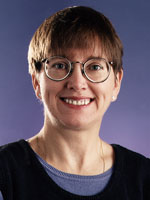
Carol Handwerker
Purdue University
Influencing the Course of Science
From ceramics and metallurgy to crystal growth and combinatorial methods, the Gordon Research Conferences have been a constant source of inspiration and community for me since 1978, when as a second-year graduate student I attended the Solid State Studies in Ceramics Conference. Over my twenty-seven years of participating in Gordon Conferences–first as a graduate student, then as a postdoc and a research scientist, and finally as a member of the GRC board of trustees–I have watched the Gordon Research Conferences influence the broader scientific community by providing what is in many cases the only venue that allows a concentrated, sustained, and open exchange of ideas.
The transformation toughening of ceramics–a process that strengthens ceramic using zirconia-based composites, heating, and cooling to change its crystal structure–was first demonstrated in 1978. It led to the use of ceramics in increasingly demanding structural applications. At my first GRC the world’s leading experts on ceramic microstructures and fracture mechanics argued about what was truly known and not known about the mechanisms that interact to produce this dramatic change in mechanical behavior. I was one of six graduate students at the meeting (three men and three women), and we were all plunged into the debate. Never had I had so much fun in my, albeit short, scientific life: there were mind-stretching talks and discussions in the mornings and afternoons; broader-ranging discussions with leaders in the ceramics field at lunch, on hikes, and at the fishing hole; and the opportunity to make contact with people who, to me, had previously just been names on the pages of scientific journals.
I attended either the Ceramics or Physical Metallurgy Gordon Conferences every year through graduate school and during my postdoctoral work. Each conference I attended lived up to my first–characterized by exceptional science, a collegial atmosphere, time off to enjoy the outdoors with colleagues and friends, and a chance to enter into the scientific fray in a substantive, sustained way. One of my most formative GRC experiences was seeing that I could influence the course of science even as a postdoc. During the discussion following a talk by a senior scientist, I pointed out that his (and other scientists’) assertion of the inactivity of a specific mechanism had not been definitively determined by experiment. When he attempted to dismiss my comments out of hand, the discussion leader obliged him to respond explicitly. He then admitted that there was no direct evidence for the mechanism’s inactivity, and he discussed what it would take to gather such evidence. During the following fall the senior scientist began a series of difficult, definitive experiments and demonstrated that the mechanism he had earlier dismissed was, in fact, the dominant one. Whether these experiments would have been done and this knowledge gained without my comments, no one can say, but it was invigorating to have had an effect on the thoughts of a scientific community.
The Ceramics Conference, which meets annually in the summer in New Hampshire, is my “home” Gordon Conference; there I have been an active participant, a speaker, a discussion leader, and a cochair (with Roger French in 1997). The conference is also home for my husband, John Blendell, who like me is a professor of materials engineering at Purdue University. He has been a GRC participant since 1976 and will chair the 2006 Ceramics Conference. GRC is a family commitment for us: I was more than eight months’ pregnant, with hospital bag in hand, when we attended the Ceramics Conference in 1985. We attended the Physical Metallurgy GRC in 1986 with an eleven-month-old daughter and a supportive grandmother in tow and went again in 1987 with John’s mother and our two young daughters. In the following sixteen years we worked out various strategies to keep going to Gordon Conferences sans children, including going separately in alternate years.
I have participated regularly in the Thin Film and Crystal Growth Mechanisms Conference and the Com-binatorial and High Throughput Materials Science Con-ference and in several others occasionally, including Nanostructure Fabrication and Visualization in Science Education. All the conferences I have attended are interdisciplinary and share characteristics with other meetings. The subject matter of the Industrial Ecology GRC is an extreme example of interdisciplinary research: this conference has brought together scientists, engineers, economists, sociologists, and urban-industrial planners to tackle as a community a common set of scientific problems. As science becomes more interdisciplinary, GRC is vital in helping new fields form. A Gordon Conference in a new research area is the litmus test for determining whether conditions are right for the formation and sustenance of a new scientific community.
As a GRC board member I have had the privilege of working with scientists who represent the full range of scientific disciplines that GRC covers and are dedicated to nurturing the scientific community through first-rate Gordon Conferences. With staff members who continue to explore ways to support our community, the GRC organization is in excellent hands.